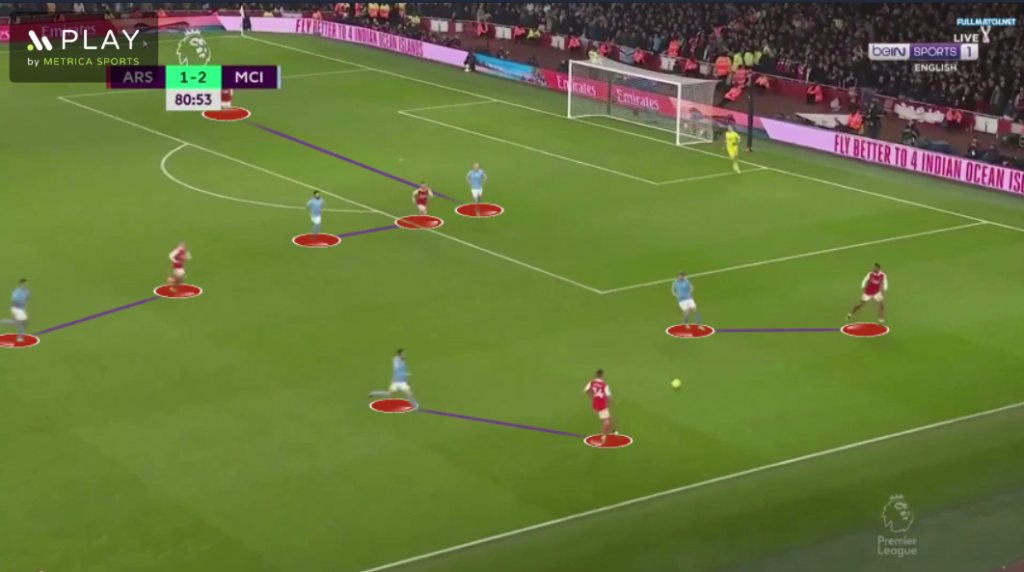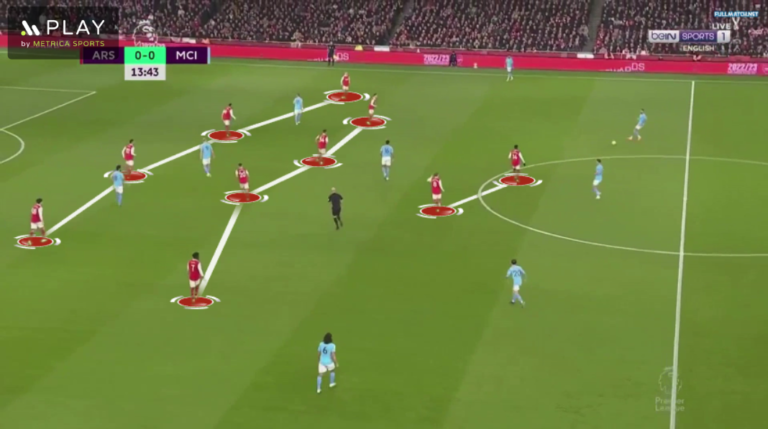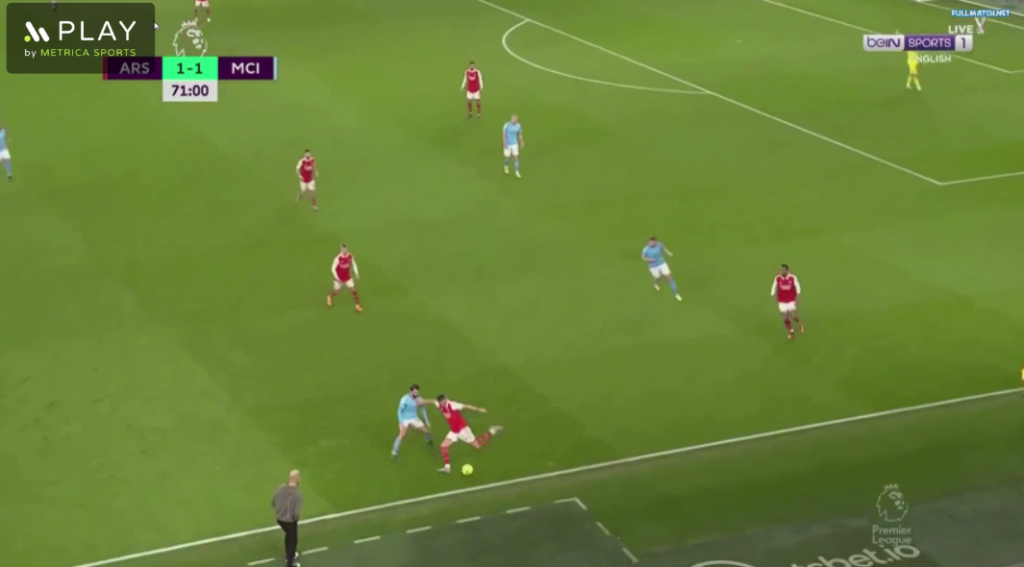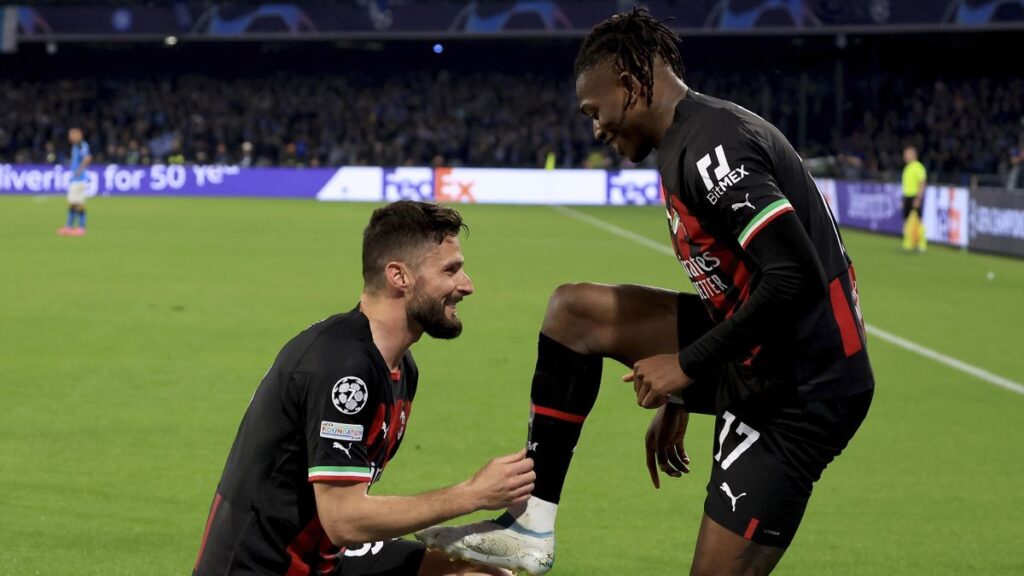In the most crucial match of the week in Premier League, the two biggest candidates in the championship race, Arsenal and Manchester City faced each other. The first and the second half of the game were like two separate matches, Arsenal dominated the match in the first half, but Manchester City took the upper hand with the changes made by Pep Guardiola in the second half and won. While Arsenal defenders left their mark with their individual mistakes, Manchester City returned home with a very important 3 points and took the leadership seat, albeit the Gunners have a game in hand. The starting 11s of the two teams in the big game were as follows:

Arsenal In Possessıon
The home team had more possession throughout the match with a massive 64%, but failed to use the ball effectively. When we look at the stats, we see that the match was generally played in Arsenal's half (despite Arsenal having more possession). This was naturally due to City's pressing style. In the first half, Manchester City allowed their opponent to have possession in their defensive third and didn't press too much up front. In the 2nd half, after the Mahrez - Akanji substitution, Manchester City put pressure much more and started to play more directly. What was interesting in the match was that when Arsenal had the ball, Bernardo Silva played in the left-back position, just like he did in the last league match and was paired up with Saka. Guardiola's choice had a direct impact on the match.
BEFORE MAHREZ - AFTER MAHREZ
I think we can divide Manchester City's off the ball play into BM and AM: Before Mahrez and after Mahrez. Until the 60th minute (when Mahrez was on), the away team started to press in the midfield and allowed Arsenal to build up play with goal kicks. The reason they chose such a cautious approach was that Bernardo was playing in the left-back position and there was a possibility of a 1v1 match-up with B. Saka. If Manchester City had chosen to press in the final third and Arsenal had broken the press, Saka could have beaten B. Silva out wide and create a dangerous scoring opportunity. When they pressed in the second third, Grealish supported Bernardo at times and created a 2v1 match-up against B. Saka, limiting his dribbling ability. After Mahrez came off and Bernardo switched to the right wing, Manchester City started to apply their usual high press. The presence of defensively strong players in the defence line made the front line more comfortable when it came to pressing. The 1v1 match-ups at the back during the pressing became less of a problem for Manchester City and they were able to send more players forward to press.

The 4-3-2-1 pressing formation of the "Blues" in the first half
During the match, O. Zinchenko shifted towards the center, next to the number 6, and Arsenal deployed a 3-2-5 formation in the opposition half. Manchester City marked opponent's 2 pivots (Jorginho and O. Zinchenko) with their wingers. When the wingers came towards the inside, it opened up space on the flanks for Gabriel and Tomiyasu. Haaland directed Saliba to the wide centre-backs. Saliba's pass to the wide centre-backs triggers Grealish and Mahrez to apply pressure. Grealish or Mahrez, who initially stood in the middle, would apply pressure and in doing so block the passing lane between the pivot and the centre-back with the ball. Arsenal were then forced to either play a risky pass to the winger or play long.

Grealish and Mahrez mark the pivot players. Ilkay and De Bruyne drop back and cover the opposition number 8s (Odegaard and Xhaka)

During this situation in the 3rd minute, we see how Manchester City encourages the opponent to play through the wide centre-backs of the 3-man defence. Jorginho signals Saliba to pass the ball to Tomiyasu

This situation makes Manchester City's intentions in pressing clear. Mahrez, covering Zinchenko at the start of the situation, applies cover-shadow to the Ukrainian and goes out to press

When Saliba receives the ball, Haaland directs the opponent to the flank and Saliba passes to Tomiyasu who is free

The pass to Tomiyasu is the trigger for Grealish to go out to press. By cutting off Tomiyasu's passing channel with the center of the pitch, Grealish forces the opponent into a risky pass
Rodri also had a special role in Manchester City's off the ball play. If the Manchester City No.8s (Ilkay and De Bruyne) were caught in front, Rodri would mark the free Arsenal No.8 and ensure that there were no unmarked players in midfield.
LEFT BACK B. SILVA'S SPECIAL ROLE IN THE PRESS
When Arsenal struggled to build-up play from the back due to Manchester City's pressure and had to play long, we saw a very interesting structure from Guardiola (and Arteta, as you will see later in the article). Normally, during pressure, the left-back marks the opponent's right winger and the center-backs cover the opponent's players who are in the midfield. Considering B. Silva's physical disadvantages, it made no sense for Ake to come forward to press and Bernardo to stay back. Guardiola, aware of this, came up with an interesting plan. Under pressure, Bernardo would come through the middle from his left-back position and Ake would pair up with Bukayo Saka on the wing. Thus, with a 3v3 at the back, Manchester City had no problems due to the high physical capacity of the players (Walker-Dias-Ake) defending air balls.

In this situation, Ramsdale sends a long ball forward. Odegaard in the middle is marked by B. Silva, not Ake

Ake wins the long ball

Similar situation. Saliba passes forward and again Bernardo comes out of his normal position to press

That leaves Ake, Dias and Walker to defend against possible long balls
TACTICAL FOULS
But what happened when Bernardo Silva paired up 1v1 with Bukayo Saka? One of the questions before the game was how good Bernardo's defensive performance against Saka would be. With Jack Grealish supporting Bernardo throughout the match, Manchester City tried to prevent Saka and Bernardo pairing up 1v1. But when there wasn't enough support, Bernardo managed to stop Saka in another way: By fouling him. With 4 fouls, the Portuguese was the player with the most fouls in the match and that's how he made up for his defensive deficiency. Pep Guardiola moved Bernardo, who received a yellow card in the 47th minute, away from the left-back position in the following minutes and prevented him from receiving a second yellow and being sent off. With his aggressive play, B. Silva prevented Saka from facing the goal after receiving the ball and consequently limited the opponent players dribbling ability.
CITY'S CHANGING PRESS Formation
After the Akanji - Mahrez substitution, with Bernardo moving to the right wing, Manchester City increased their high pressure. Having 4 players with high physical skills in the defence strengthened City's pressing and the front line players were able to press more comfortably. As a matter of fact, Arsenal couldn't adapt to their opponent's pressing and had serious problems in the build-up. After the game, Guardiola also talked about the differences between the first half and the second half. His comments are as follows:
In the first half, Arsenal were much better than us, maybe because I changed something & it was not good enough. In the second half, we were much more aggressive & much, much better. From the first minute of the second half we pressed much higher and more intensely
In the first half, we saw that Manchester City allowed their opponents to have possession in their defensive third. In the 2nd half, they pressed intensely directly from the goal-kick. They tried to create 1v1 match-ups all over the pitch and prevent the home team having possession. City were successful in this as they created dangerous opportunities when they gained possession, two of which resulted in goals.

City's pressing structure in the second half. If Zinchenko was not in the center but on the wing, Bernardo was marking him, while De Bruyne was applying pressure on Gabriel

Match-ups that emerge due to the away team's pressure in the final third

The situation right before City's third goal. Similar match-ups again

With Haaland leaving Saliba and moving to the right flank, City have a 5v4 numerical superiority in the pressing area

Arsenal players send the ball forward to Martinelli but he can't control the ball due to pressure from K. Walker. City score on the counter attack after the turnover

In the 68th minute, we see that the "Blues" applied pressure on the opponent again on the right flank. Under pressure from De Bruyne and B. Silva, Zinchenko loses the ball in a dangerous area

Haaland can't score after receiving Bernardo's pass
Arsenal had some problems in this match, both in terms of moving the ball into the final third and in terms of making the most of their chances. Especially E. Nketiah was unlucky in this match and failed to score 2 dangerous headers. Nevertheless, it was possible to see some of Arsenal's final third principles in the first one.

In the 21st minute, we see the 5-man attacking line that Arsenal uses every game. At the back, Zinchenko, Jorginho and Tomiyasu provide defensive security against turnovers. It is also possible to see B. Silva's air ball weaknesses in this situation

Nketiah's header has a very high xG of 0.29. But the young player can't convert the position into a goal
Manchester Cıty In possessıon
Manchester City struggled to find scoring chances (except set pieces) in the first half. Their inability to be aggressive enough in the press also affected their on-ball play and they failed to create any serious chances apart from set-pieces. In the 2nd half, after Akanji came on, we saw an unfamiliar Manchester City game. Trying to move the ball into the final third with Ederson's long balls, regained balls that bounced off the opponent or won the ball with their pressure during goal kicks and tried to attack the opponent's goal in a fast and direct way and they were successful in this. In particular, City tried to take advantage of Haaland's physical advantages, were able to send more players forward to press, and found clear goalscoring opportunities by catching Arsenal off guard with intercepted passes. Arsenal, on the other hand, failed to adapt to this change. Manchester City had 36% of the ball throughout the match, which we are not used to, showing us once again that possession statistics are meaningless and it's what you do with the ball that matters. In the first half, Arsenal were successful when it came to pressing. Manchester City's left-back B. Silva came towards the center, next to Rodri, and the result was a 3-2-5 formation. On the other hand, Arsenal (as they did in the cup match as well) used man-to-man defence to prevent Manchester City from having possession. They didn't give the opponent too much space between the lines as they pressed intensely. O. Zinchenko played a special role in this, just like B. Silva.

During the press, Saka and Martinelli are marking the wide centre-backs. In the center there are the Bernardo - Odegaard and Rodri - Xhaka match-ups

In this picture we can see the 1v1 match-ups that emerged at the back. The interesting thing here is that left-back Zinchenko comes into the center and marks De Bruyne. Meanwhile, Mahrez is being marked by left centre-back Gabriel. The advantage of this is that the player defending against long balls is Gabriel, who is better at winning long balls, rather than Zinchenko

Manchester City's 3-2-5 formation. We know that Xhaka is normally paired up with Rodri. But when Nketiah was applying cover shadow on Rodri, Xhaka would not come forward and cover the space in the center instead

Arsenal win a penalty. The hosts regain the ball with their pressure and then quickly move the ball into the penalty area and win a penalty
MANCHESTER CITY'S FIRST GOAL
Although Arsenal's man-to-man press worked in the first half, the pressing style they chose was not without its risks. One of these risks led to a goal. While many would argue that it was only Tomiyasu's individual fault, it was De Bruyne's complete control of the situations that developed on the pitch that led to the goal.

Before the goal in the 23rd minute, we saw Arsenal pressing with 1v1 match-ups once again

After Ederson's long ball, Saliba can't get the ball down and it goes straight towards Tomiyasu. The player who deserves applause in this situation is De Bruyne. When we look at the Belgian's starting position, we see that he is behind both of Arsenal's centre-backs

Realizing that Gabriel is not following the ball, De Bruyne is aware that Tomiyasu's only passing option is the goalkeeper and positions himself accordingly

De Bruyne reaches the ball in front of the box before Ramsdale does, and curls the ball over the goalkeeper with his left foot to give his team a 1-0 lead
When Manchester City were able to settle in the final third, Arsenal responded with a 4-4-2 formation. Arsenal, not a team that likes to stay deep, pushed the opponent back into their own third and continued to press high. That's why we didn't see much of the 4-4-2 structure in the match.

Arsenal's 4-4-2 formation in the defensive third
MANCHESTER CITY'S CHANGING STYLE OF PLAY
In the 2nd half Manchester City changed their style of play. They tried to move the ball forward in a much more direct and risky way than they normally do. After losing possession, they applied gegen-press to get the ball quickly and catch Arsenal off-guard, and they succeeded in this plan. We can even say that they took control of the match by "giving up the control of the ball". They took advantage of Ederson's passing ability and Haaland's physical strength to score the second goal. In fact, Ederson played 26 long balls in the match. When we look at the stats, this is much more than Ederson normally would do. In the 2nd half Arsenal couldn't keep up with this change and lost control of the game.

At the start of this attack, Ederson plays a long ball to Haaland. Here we see how City players draw Arsenal players to them and create space for Haaland and others up front

Haaland prevents Saliba from controlling the ball properly. The rebound goes to Zinchenko and then to Xhaka

Xhaka is forced to play long after Bernardo's pressure

Having won the ball, the City players do not linger and send the ball forward quickly. Finally, the Arsenal players regain the ball by intercepting the pass from Walker to Bernardo

De Bruyne and Bernardo, who insist on regaining possession, once again apply gegen-press and Bernardo receives the ball

This situation in the 71st minute shows us a lot about City's plan in the 2nd half. Bernardo, who could have played the ball to the safer option of Ilkay, wants to get to the opponent's goal as soon as possible, so he plays it into Haaland's path and City score the 2nd goal
Conclusıon
The clash of 2 top teams and 2 genius coaches had us expecting a lot in terms of tactics even before the game. As a matter of fact, the expected tactical battle took place. In a match where two separate halves were like two separate matches, Manchester City managed to gain a very valuable 3 points. The success of Manchester City's pressing, especially in the 2nd half, was also evident in Arsenal's 0 xG between the 28th and 83rd minutes (excluding the penalty). If we count Arsenal's individual mistakes and missed clear chances, we can easily say that there was no clear team dominating the match but the first half was dominated by Arsenal and the second half by Manchester City. In the 2nd half, Guardiola turns the tide and was the tactical winner of the match.



